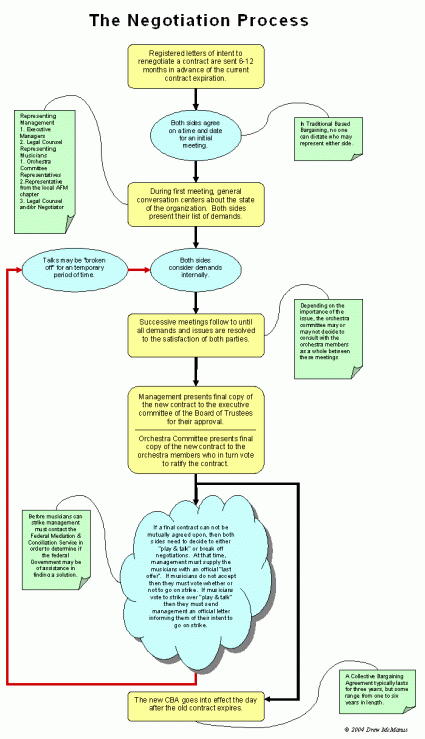The first step at better understanding how your local orchestra functions as an organization is to understand the basic principles behind the document that deals with nearly every facet of its operations: the CBA, or Collective Bargaining Agreement. Every major orchestra in America, regardless of union affiliation, has some form of a contract that exists as a result of collective bargaining. This contract governs all issues related to musician compensation, benefits, work conditions, and dismissal issues.
The negotiation process is straightforward in that two parties get together and figure out how their working relationship will function. Although each orchestra conducts this process in their own unique way, the following chart outlines the basic, traditional negotiating process:

Many of the orchestras that are currently involved in negotiations are somewhere between the second and third yellow box. But all of them have deadlines to reach an agreement on a new contract by the beginning of their 2004-2005 concert season, which is typically in the middle of September.
It’s difficult to ask a manager or musician or board member about contract negotiations without eliciting some sort of distinct emotional response. Negotiations have served the industry as a beautifully double edged sword: it is both a source of great anxiety and frustration among stakeholders while at the same time serving as the great motivating force that fuels artistic and financial expansion and of the organization.
In upcoming articles, we’ll begin to examine how this template has evolved over time and where it’s heading. We’ll also look at alternatives to this process and how attitudes among individuals in this business have helped drive the evolutionary process.
We’ll hear from veteran musicians, infamous managers, and notorious negotiators that have “been there and done that” in this industry. Additionally, we’ll hear from some orchestras that have developed unique variations on the basic template.
It’s sure to be exciting, revealing, and (most importantly) productive. So stay tuned



I’d love to be able to read this. I teach negotiation at my own shop and at the Straus Institute. Can you make it into a downloadable .pdf?
Hi Vickie, I recently updated this chart last week. you can find the new version at https://adaptistration.com/2010/08/17/the-negotiation-process-reloaded/
and you can download the image file at https://adaptistration.com/wp-content/uploads/negotiation-process.png. You can then save the image file in whatever document format you prefer.
However, please note that this blog’s creative common’s license prohibits derivative and commercial use of any material and requires attribution. As such, feel free to use it for your academic work but not for business purposes.